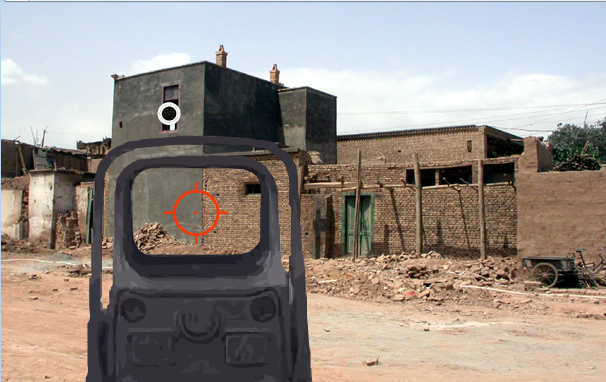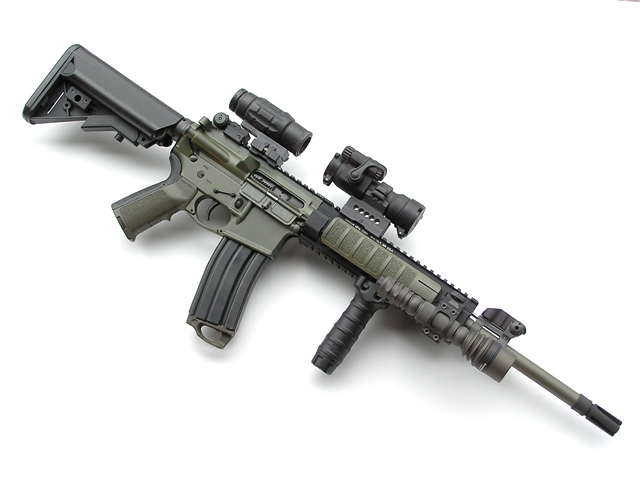Welcome. My first goal is to help you choose a red dot sight with this guide. Nothing is more important to me than to help equip you with the best tool to protect yourself, your family, and potentially your nation. With your first AR15 purchased, it won’t be long before you start looking at upgrades, and there are a ton of optic options. The best red dot sight for your needs might be a poor choice for someone else. There are a variety of styles that you can choose from and I have put together this guide to point you in the right direction based on your needs and price range.
Red Dot Sights
The red dot sight has become a common choice for a first upgrade and the low-cost of entry makes it a very attractive option. A red dot sight has a red (or green) dot (or other reticle patterns) and the dot is placed on the target and the weapon is fired. Historically, a “red dot” or reflex sight can go back quite far, as far as the 1900s and the Nydar Sight. These predecessors bear similarities to red dots save for the LED illumination which came much later. Modern red dot sights use a clear lens and reflector to superimpose a dot on the target, and they utilize everything from fiber optics to holographic technology. The first step is to choose a dot size and shape that will best fit your uses.
Dot Size, Dot Pattern
Choosing the wrong reticle for your use can be a hindrance. Making the proper choice of dot size and shape is dependent on your uses. Too small a dot and it won’t be as quick to pick up by the eye. Too large a dot and the dot can obscure your target if you are shooting at longer distances. Some red dot sights attempt to fix this issue by allowing a large circle dot reticle where there is a large ring with a precision dot in the center.The Eotech reticle is a perfect example. Deciding what dot to choose is the first step, and it is important to pick something that will suit your uses.
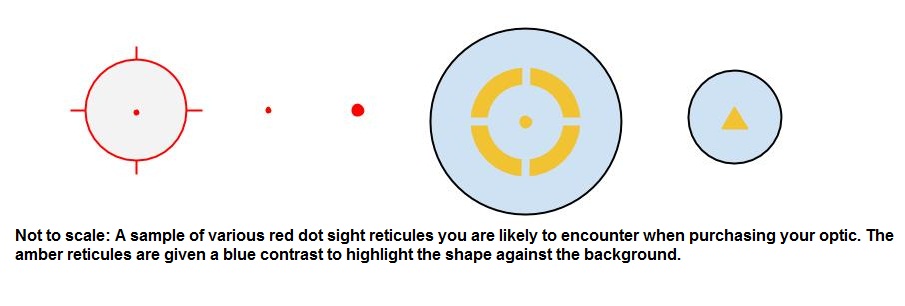 A simple 4 MOA dot will suit a general purpose rifle well. It is small enough to allow precision at medium range distances and large enough to be quickly picked up by the eye. Be wary of products that allow you to switch reticle patterns. These products have a reputation of being UN-reliable or often on the cheaper side of the fence. There are exceptions, but as with anything, do your research.
A simple 4 MOA dot will suit a general purpose rifle well. It is small enough to allow precision at medium range distances and large enough to be quickly picked up by the eye. Be wary of products that allow you to switch reticle patterns. These products have a reputation of being UN-reliable or often on the cheaper side of the fence. There are exceptions, but as with anything, do your research.
Range Estimation with Red Dot Sights
A red dot is also useful for rough estimation of range. Choosing a red dot with the right size can help with basic distance and holdover estimates. It’s not as simple as just choosing a dot! With the right holdovers and good distance estimates, you can score hits with a red dot easily to 400 yards on a man sized target. I whipped up the chart below to evaluate dot size for ranging estimates. Blue = distance where the dot starts to obscure the head Red = distance where the dot is roughly shoulder width Ammo: 55 grain 5.56×45 at 3240 FPS with a 50 yard zero.
| Yards | 5.56×45 | 2 MOA | 3.5 MOA | 4 MOA | 7 MOA | |
| 100 | 0.9 | 2 | 3.5 | 4 | 7 | |
| 150 | 1.1 | 3 | 5.25 | 6 | 10.5 | |
| 200 | 0 | 4 | 7 | 8 | 14 | |
| 250 | -2.4 | 5 | 8.75 | 10 | 17.5 | |
| 300 | -6.4 | 6 | 10.5 | 12 | 21 | |
| 350 | -12.3 | 7 | 12.25 | 14 | 24.5 | |
| 400 | -20.4 | 8 | 14 | 16 | 28 | |
| 450 | -30.9 | 9 | 15.75 | 18 | 31.5 | |
| 500 | -44.3 | 10 | 17.5 | 20 | 35 |
For more information on ranging with red dots click here.
Positioning the Red Dot Sight
Red dot sights can have a tube effect if positioned too close to the eye. Best practice is to place the optic further from the eye to mitigate the effect and shoot with both eyes open. Certain red dot sights lack a tube or have a very short “tube” and thus there is less area occluded by the body of the optic. Any “tube effect” can be negated by placing the optic further away from the eye. One thing of note is that the bigger the lens the more the dot can move around the viewing area. Quality red dots are parallax free after a specified distance which means the dot can be anywhere in the viewing area and your shots will still hit the target. This is helpful when shooting from unconventional positions. The dot does not need to be centered in the glass.
Entry Level Red Dot Sights:
Let’s get started with some of my recommendations for affordable red dots. As the red dot technology has matured, we have seen a large influx of products that are feature filled, budget friendly, and most importantly… durable. I try to keep an eye out for quality products on a budget for readers who may not have $400 dollars to throw at a Aimpoint. Atibal and Primary Arms are two companies that offer affordable red dot sights that are tough enough for use on a AR15, and they retail for $150 or less. Optics that are in this price range need to come from reputable companies, so do research if you aren’t sure. I can personally recommend both Atibal and Primary Arms as I have experience with their product lines and would recommend them to new shooters. Both Jimmy (from Atibal) and Marshal (from Primary Arms) will take care of you if something goes wrong with their optic, and that’s very important to me if I recommend something. Rock solid customer service does great things for our community. Another commonly recommended budget red dot is the Burris TRS-25 which has also shown it can handle some abuse.
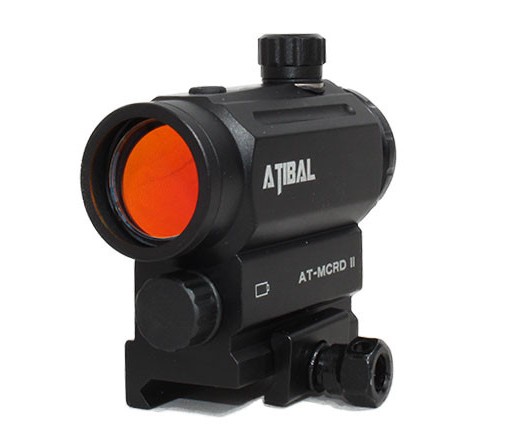
The Atibal MCRD-II has an automatic brightness control as well as manual override and it takes a common AAA battery. Pretty nifty features in this price range.
Battery Free vs Electronic
Battery free red dots are often discussed in SHTF scenarios. Inevitably “reflex style” battery free optics are discussed. Reflex style sights have no electronics to fail, and often these items are illuminated with tritium to give them low light function. The Achilles heel of these type of optics are that they can wash out in various lighting conditions with no way of increasing the dot intensity manually. If you want to run a system without batteries, you must also consider setting up your weapon to accommodate the deficiencies of reflex style sights. I would suggest constantly deployed irons to give you something to aim with should the dot wash out.
A battery free “reflex” style red dot sight: Trijicon RMR
Electronic red dot sights are becoming more efficient and reliable as time goes on. At the highest levels of quality there is patented technology that allows the Aimpoint CompM4 to run for 8 years of continuous use. From there, the various models available will range from thousands and thousands of hours to hundreds of hours. The technology packed into red dot optics are constantly improving in both durability and longevity. It is a constant point of argument that higher quality electronic red dot sights are so reliable that the benefits of fiber optic powered models are a moot point.
A new contender in the battery free arena is the See-All Open Sight. It’s a unique design that differs substantially from the reflex style sights.
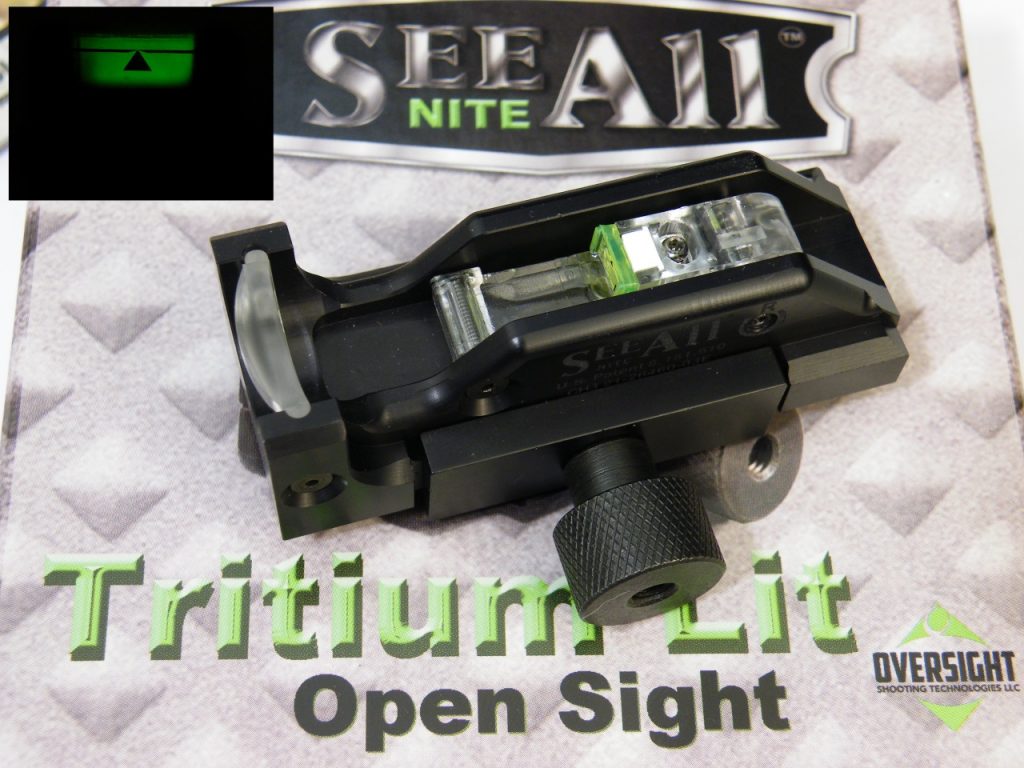
Some products, such as the See All Nite sight, use a tritium lamp to ensure the reticle glows for a decade without batteries.
Most battery free red dots project a reticle on to a window via fiber optics. The See-All takes a different approach as it doesn’t project an image on to a window, but rather projects it on to a lens which magnifies the reticle. The tritium model above has a tritium lamp that should glow for about a decade or more.
Micro Red Dots:
Trijicon’s new MRO offers a larger objective lens for less of a tube effect
The trend for red dot sights to shrink in size has continued. The Aimpoint H1 and T1 are considered category leaders in the micro red dot category and are well established, but as of 2015 Trijicon aims to take some market share from Aimpoint with the equally impressive Trijicon MRO. If you want to run a lighter setup and don’t mind obtaining some coin sized batteries, consider some of the smaller red dot products. The lighter weight and small form factor will give you a less bulky weapon. While they may be small, the category leaders offer up to five years of battery life and can easily take the place of full sized red dots. Some additional models to look at are the Trijicon RMR series and Eotech’s MRDS.
Full Size Red Dots:
Having owned a full size Aimpoint COMP-M4, at this point in time I would point new shooters towards the smaller micro red dot category since they are quickly becoming just as tough and reliable as their full size counter parts. The weight savings is also substantial and the performance and durability is quickly catching up to their older, heavier relatives. However, if you want a COMP-M4 because that’s what the military uses, go for it! Just be prepared to shell out nearly $800 dollars and in my opinion the cost to value ratio does not favor the investment. The Aimpoint Pro is a full size red dot with a more palatable $400 dollar price tag, but even then the product trend is to make red dots smaller and lighter. At this point in time, I would recommend new shooters stick with the micro red dot category as they can offer everything a larger dot sight can, but often with less weight and sometimes less price.
DI Optical’s EG1 red dot is a full size optic, but in a small form factor with a huge field of view. A very interesting “full size” option!
Should You Purchase a Red Dot or Go For Magnification?
A red dot optic is a common choice for your first upgrade to the AR15. A red dot will help your shooting improve by giving you a great visual aid that is faster than iron sights and can be used more precisely with less eye strain. Remember that a 2MOA dot is *far* smaller than the width of the front sight post on your AR15. The red dots can be used at the very least with as much precision as iron sights inside of defensive ranges.
One of the great advantages of red dots over low power or variable power optics is costs. I prefer a bit of zoom, but a quality optic will cost more than a quality red dot and the red dot optics have a weight advantage over low magnification scopes. If your primary concern is a 0-300 yard defensive range, a red dot should suffice well for this role. One way to add versatility (and weight) to your red dot sight is to add a magnifier. Magnifiers can be added on as a later addition to give your red dot a bit of magnification.
Such a setup is a versatile “compromise” system. Not as clean as say a 1-4x variable, nor will it weigh less than an 4x ACOG setup, but it does give the option of adding or removing the magnification as needed. There is no perfect setup, so you need to balance your shooting needs with a system that will meet your goals.
A Personal Recomendation:
Lothaen, if you had to recommend one red dot sight for me, what would it be? That’s Easy.
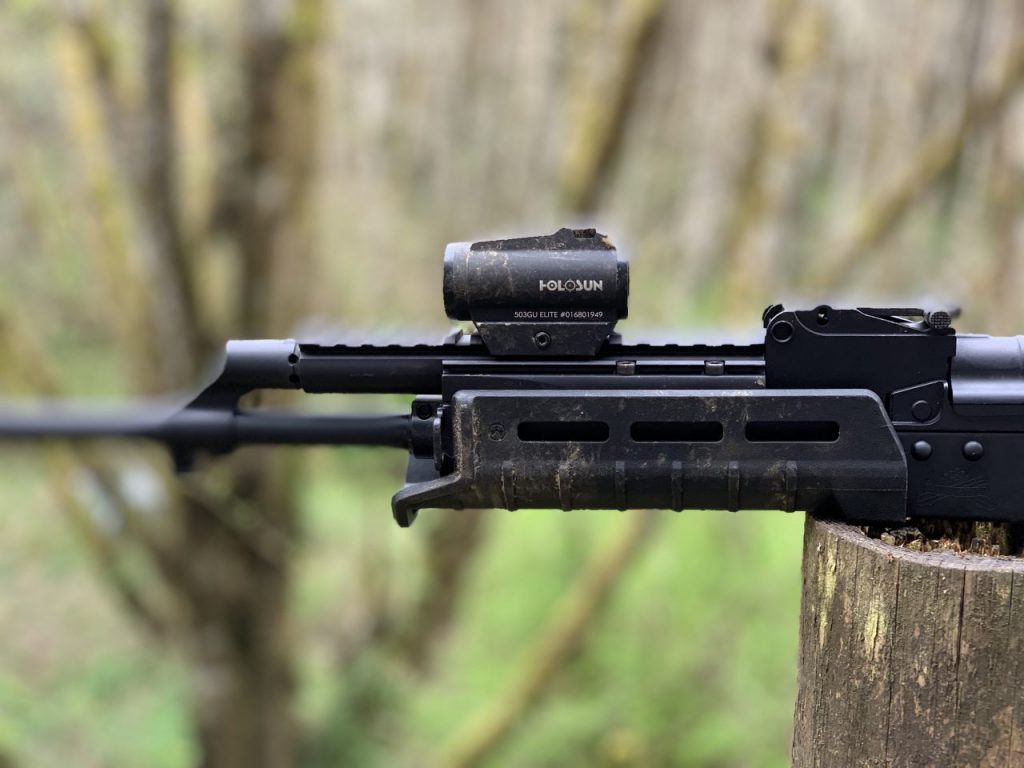
Side view of the Holosun 503GU
Holosun. That’s right. Holosun has been making headway in the optics world by offering feature-rich red dots (with multiple reticles even!) and no BS durability. This company has caught us all off guard with their deluge of new models and high praise from shooters for their durability and value. Check out the models at Brownells, our Sponsor by clicking here. I own two, D.S. owns one and we have both been impressed by the brand. They have been kicking ass.
Next up in my recommendations would be the Primary Arms MD-25 which I reviewed here.
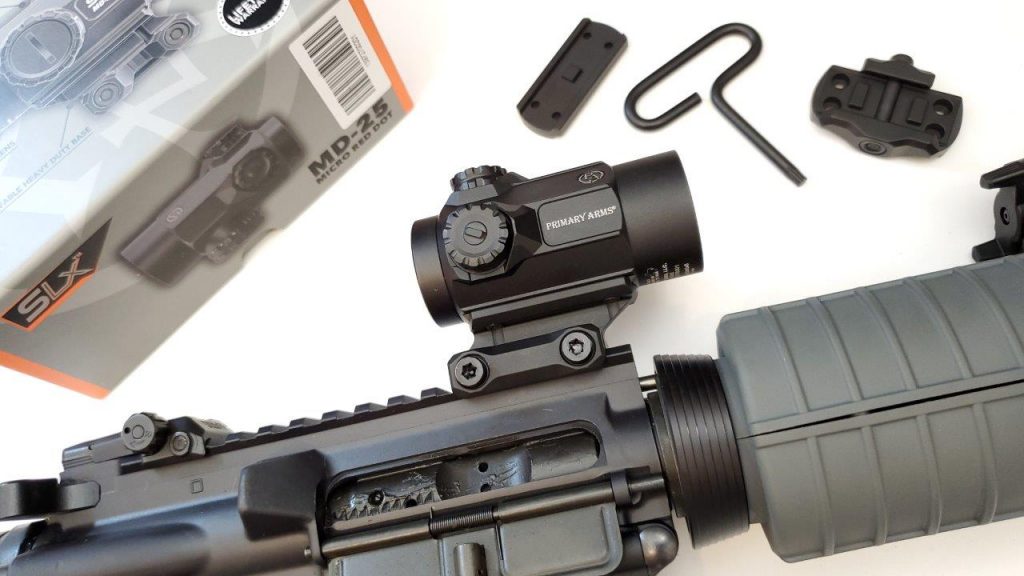
This one has been solid in testing so far, and is another choice for the shooter on a budget.
Wrapping Up:
A red dot scope / optic is a great first upgrade. Remember that your AR15 is a very accurate machine. As a defensive rifle it will do its part to get rounds on target. Buying a red dot scope to augment your ability to quickly acquire and fire upon the target is an excellent first upgrade. The wide variety of models and design goals means you should choose a system carefully based on your shooting goals. A quality red dot will give you a precise aiming point that is both faster than iron sights and (depending on dot size) more precise than irons as well. Save your money and go for a quality system and you will be quite happy with its durability and performance.
Special thanks to Rainier Arms: been a customer for years and they always bring their A game!





